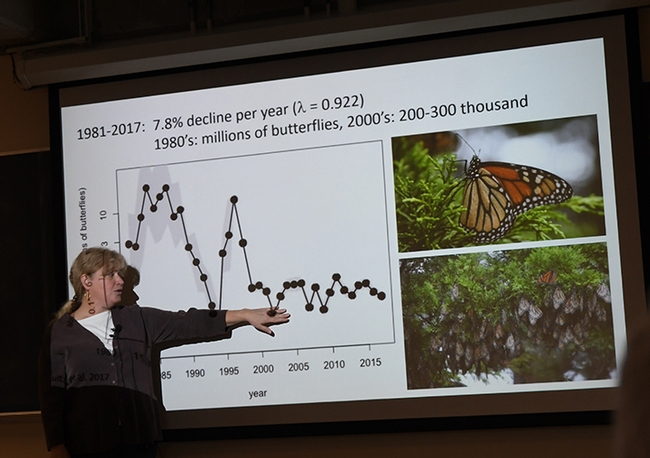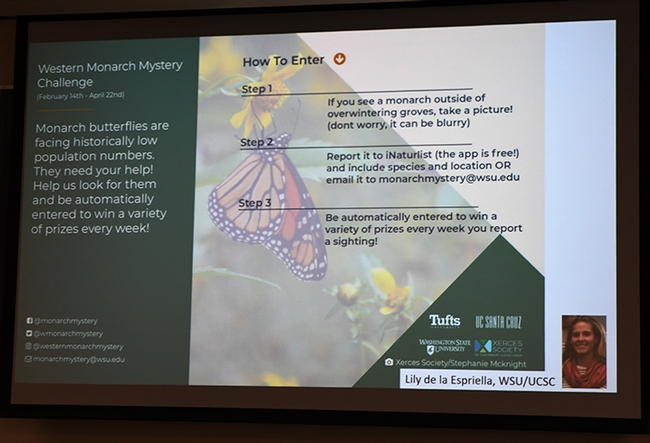- Author: Kathy Keatley Garvey
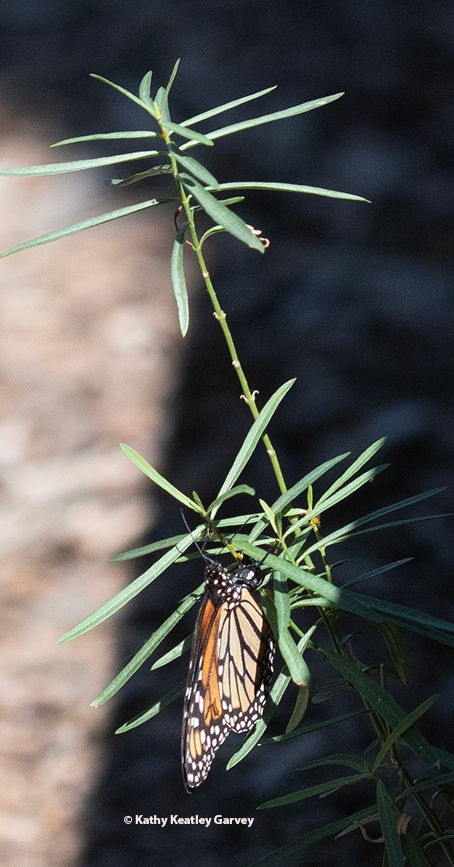
Where do Western monarchs go after leaving their overwintering sites along coastal California in February?
An observation: They didn't stop in the spring or summer to deposit eggs on any of our four species of milkweed in our Vacaville pollinator garden.
Spring? Zero. Zilch. Nada.
Summer? Zero. Zilch. Nada.
Fall? Yes.
Why not spring and summer? Did the monarchs passing through Vacaville opt for "a better habitat" in the cooler Pacific Northwest and beyond (British Columbia)?
"I wish I knew," commented UC Davis distinguished professor emeritus Art Shapiro, who has monitored the butterfly populations of Central California since 1972 and maintains a research website, Art's Butterfly World.
Beginning in September, as many five monarchs a day began fluttering into our garden. Some laid eggs.
To date, we've spotted some 20 eggs and caterpillars.
"This is generally consistent with the pattern we've seen in previous years," said UC Davis Department of Entomology and Nematology professor Louie Yang, who researches monarchs. "Even in Davis, we've been seeing more caterpillars in the late summer/fall. I think this is probably because some are stopping to lay eggs on the return migration, and the fall population is much larger than the spring migration population. Looking very carefully, we did also see eggs in the spring each year, but very few of them developed into large caterpillars." See the Louie Yang et al, research paper, "Different Factors Limit Early- and Late-Season Windows of Opportunity for Monarch Development," published in July 2022 in the journal, Evolution and Ecology.
The availability of food resources, such as tropical milkweed (Asclepias curassavica) that can overwinter in warmer climates, doesn't deter them from migrating, said UC Davis emeritus professor Hugh Dingle of the Department of Entomology and Nematology. Dingle, an internationally known expert on animal migration who has studied monarchs for more than two decades, said: "Migration and the diapause that accompanies it in the fall are determined by shortening photoperiod and temperature (warm temps can override short days hence the issue with climate change)."
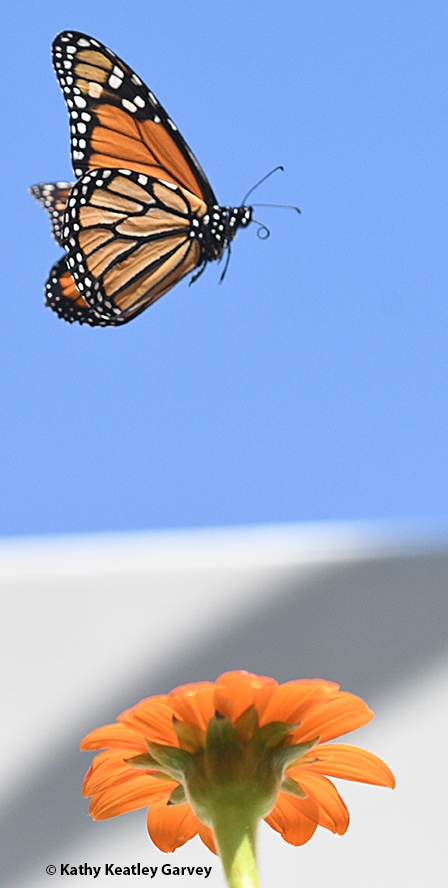
Said UC Davis professor Elizabeth Crone of the Department of Evolution and Ecology: "Monarchs may behave similarly in spring, but the spring population is probably much smaller than the fall one, so they are less likely to happen across your garden. Our estimate is that the population increases 2-3x each generation (so it's about 100-200x larger in Fall than Spring), then resets each year due to mortality during Fall migration and overwintering. There is some research from Sonia Altizer's lab in Georgia showing that monarch butterflies that encounter milkweeds during fall migration will leave reproductive diapause and breed. It is unknown whether these monarchs are effectively lost from the migratory population, or whether they or their offspring (the caterpillars in your yard) will continue on to the overwintering sites."
"The egg-laying females you are seeing now are likely migrants that have eschewed reproductive dormancy for reproduction," says entomologist David James, an associate professor at Washington State University who researches migratory monarchs. "This has probably always happened to some extent but is likely more significant now because of warmer falls."
"The lack of activity in summer in Vacaville was probably a function of most of the population having dispersed further east and north, maybe more than usual? They surely did pass through Vacaville in spring on their way north but clearly didn't stop to use your milkweeds. It does seem that some years they are more prone to frequent stopping/oviposition on their way north and east, yet in others they just keep flying. There's evidence that the latter was the case this year... with as many migrants making it to BC as to Washington... Normally they stop in Washington and only a handful make it to BC."
"The many mysteries of monarchs," James added.
James is the author of a newly published book, The Lives of Butterflies: A Natural History of Our Planet's Butterfly Life (Princeton University) with colleague David Lohman of the City College of New York. The book, released in the UK on Oct. 3, 2023, will be available in the United States starting Jan. 9, 2024.
Irish scientist Éanna Ní Lamhna recently interviewed the WSU entomologist in a podcast on RTÉ, or Raidió Teilifís Éireann. The book, she said, "showcases extraordinary diversity of world's butterflies, while exploring their life histories, behavior, conservation and other aspects of these most fascinating and beguiling insects." (See Bug Squad blog)
Listen to the butterfly podcast here: https://www.rte.ie/radio/radio1/clips/22294525/
Meanwhile, are you seeing fall breeding and egg-laying in your garden? We have for more than a decade, with some monarchs eclosing in November and December.

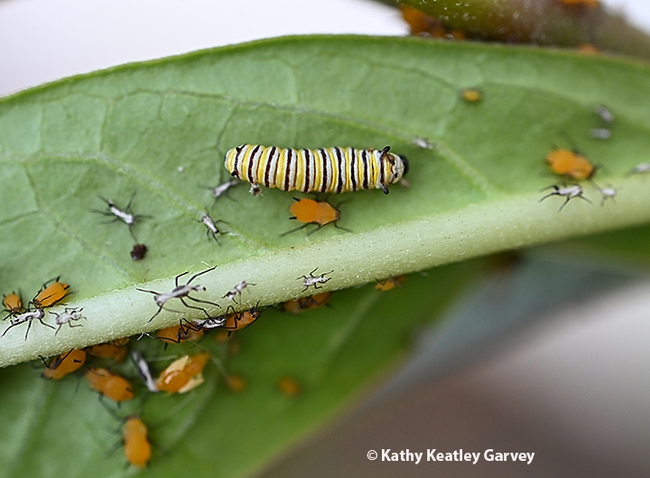
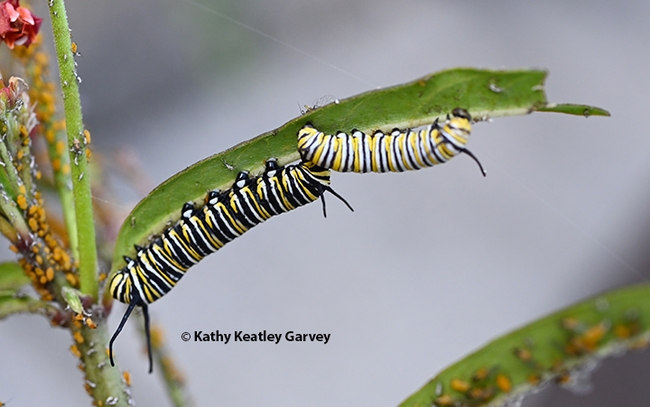
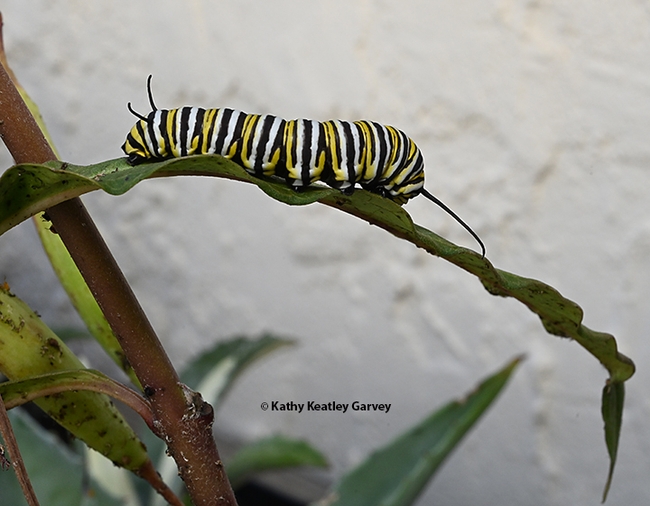
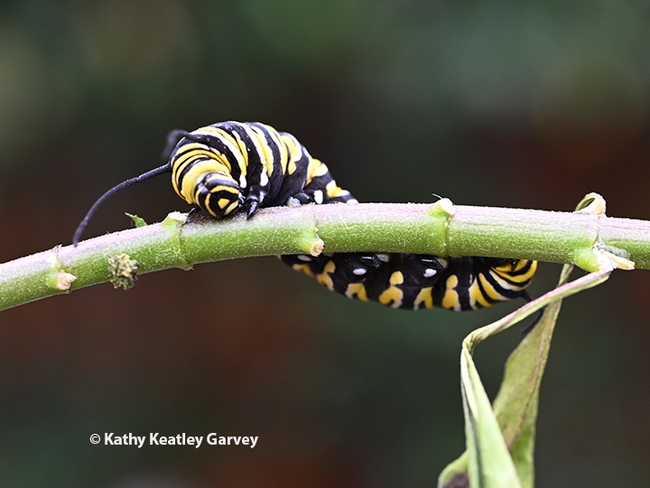
- Author: Kathy Keatley Garvey
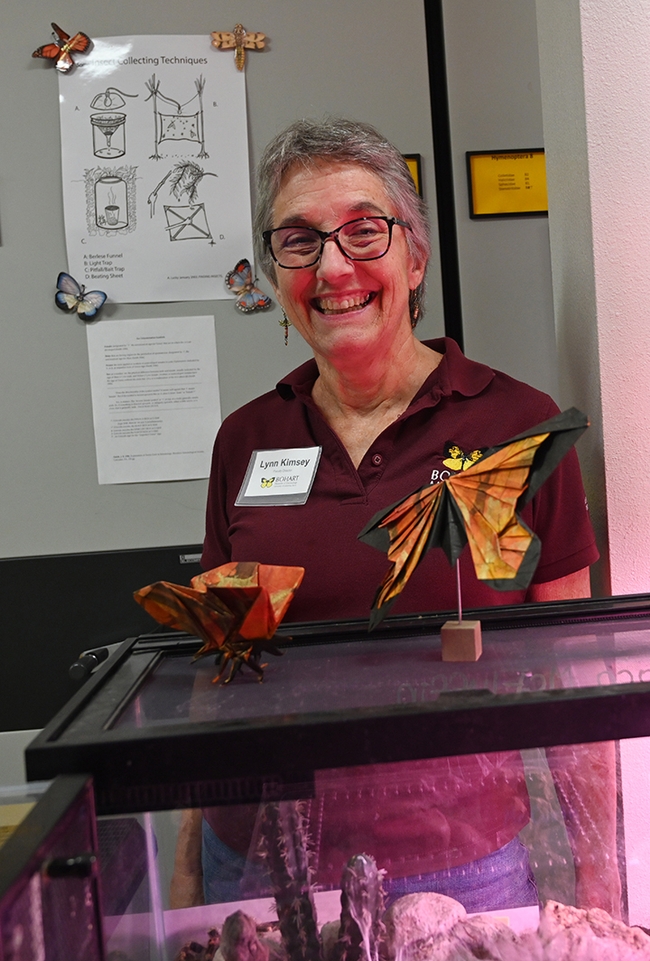
Western monarchs are now settling in their overwintering sites along coastal California, but the iconic butterflies showed up in force at the Bohart Museum of Entomology's recent open house--in the form of specimens, photographs, books, maps and displays.
Some 650 visitors arrived to talk to the scientists, see the displays, and take home native milkweed seed packets, provided by community ecologist Louie Yang, professor of entomology, UC Davis Department of Entomology and Nematology (ENT-NEM). Yang shared seeds of narrow-leafed milkweed, Asclepias fascicularis.
Statistics show that the overwintering population of western monarchs along coastal California has declined by more than 99 percent since the 1980s, according to the Xerces Society for Invertebrate Conservation, but the population has been showing a mini-boom in recent years. Scientists blame habitat destruction, pesticide use, and climate change as the primary causes of the decline.
Scientists participating in the open house were:
- UC Davis distinguished professor emeritus Art Shapiro of the Department of Evolution and Ecology, who has studied butterfly populations in central California since 1972 and maintains a research website, Art's Butterfly World.
- UC Davis emeritus professor Hugh Dingle, a worldwide authority on animal migration, including monarchs. He is the author of Migration: The Biology of Life on the Move (Oxford University Press), a sequel to the first edition published in 1996. (See news story on the ENT-NEM website.)
- UC Davis professor Louie Yang, who does research on monarchs and milkweed and has been featured nationally. (See news story about his work.)
- UC Davis professor Elizabeth Crone of the Department of Evolution and Ecology, formerly of Tufts University, who researches monarchs. (See news story about the declining monarch population on the ENT-NEM website.)
In addition, the Bohart Museum showcased monarch photography by Larry Snyder of Davis and Kathy Keatley Garvey of ENT-NEM.
Yang and Crone were among the 12 nationally invited scientists who delivered presentations during the two-day Monarch Butterfly Summit, held last year at the Capitol in Washington D.C. and organized by Sen. Jeffrey Merkley of Oregon, During that summit, the Department of the Interior announced a $1 million award to the National Fish and Wildlife Foundation's Monarch Butterfly and Pollinators Conservation Fund, and the U.S. Fish and Wildlife Service announced a Pollinator Conservation Center. (See news story)
In another project, Yang organized and led a three-year study of wild monarch butterflies and milkweed in rural Davis. The project, funded by two of Yang's National Science Foundation grants, involved UC Davis, Davis Senior High School and the Center for Land-based Learning, Woodland. The 135-member team included 107 high school students, a K-12 teacher, 18 UC Davis undergraduates, three graduate students and two postgraduate researchers.
"This study collected a high-resolution temporal dataset on milkweed-monarch interactions during the three years prior to the precipitous single-year population decline of western monarchs in 2018,” Yang said. From 2015 through 2017, the team monitored the interactions of monarchs, Danaus plexippus, on narrow-leafed milkweed, A. fascicularis, planted in December 2013 on city-owned property.

“This study has three key findings,” Yang related. “First, we documented early and late seasonal windows of opportunity in the wild, migratory western monarch population. Second, our data suggest that early and late seasonal windows were constrained by different factors. Third, climatic and microclimatic variation had a strong effect on the timing and importance of multiple factors affecting monarch development. Broadly, we hope that this study contributes to a more temporally detailed understanding of the complex factors that contribute to year-to-year variation in monarch breeding success.” (See news story on ENT-NEM website)
In February of 2022, Yang appeared on Science Friday, National Public Radio, in an interview titled "How Long Will California's Butterfly Boom Last?"
Hugh Dingle. Professor Dingle, an internationally known expert on animal migration, has researched animal migration for some 50 years. In the last two decades, he has focused on monarch butterflies. National Geographic featured him in its cover story on “Great Migrations” in November 2010. LiveScience interviewed him for its November 2010 piece on “Why Do Animals Migrate?”
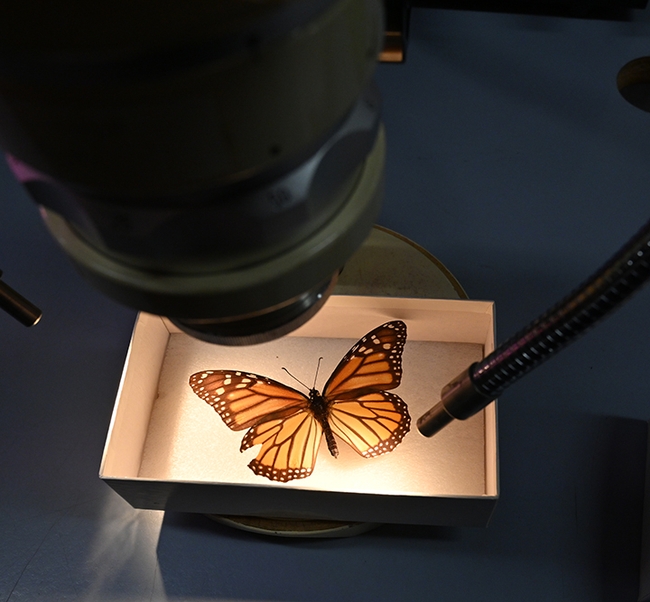
Dingle says:
- "There is not enough tropical milkweed planted to have much influence (see the amount of A. syriaca and A. fascicularis throughout the American West not to mention various other species like A. erosa, cordifolia, californica, etc.) Yes, there are parasites on A. curassavica as there are on ALL milkweeds."
- "There are populations of monarchs that are doing just fine feeding exclusively on A. curassavica (e.g. on many Pacific Islands, such as Guam where I have studied them."
- "Migration and the diapause that accompanies it in the fall are determined by shortening photoperiod and temperature (warm temps can override short days hence the issue with climate change). There is no significant influence of food plant."
Elizabeth Crone. Crone focuses her research on population ecology, "especially of plants and insects, and plant-animal interactions. Specifically, I am interested in how environmental changes translate to changes in population dynamics in animals. I was also one of the first ecologists to use generalized linear mixed models to parameterize stochastic population models." She co-authored "Why Are Monarch Butterflies Declining in the West? Understanding the Importance of Multiple Correlated Drivers," published in 2019 in Ecological Applications, Ecological Society of America.
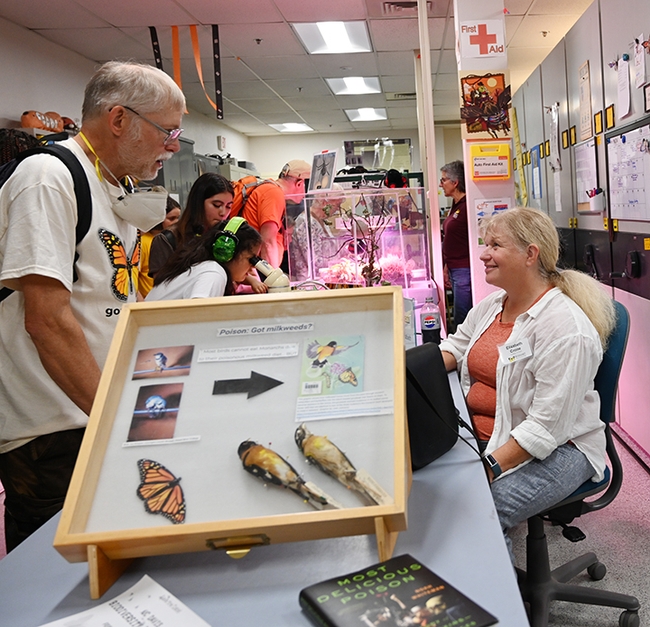
Art Shapiro. Professor Shapiro shared several handouts, including "Comments on Monarchs." He co-authored research (lead author Anne Espeset and six other colleagues) titled, "Understanding a Migratory Species in a Changing World: Climatic Effects and Demographic Declines in the Western Monarch Revealed by Four Decades of Intensive Monitoring," published in Population Ecology.
"None of my group is a Monarch specialist, and that includes me," Shapiro wrote in the handout. "Since 1999 I have done counts of all butterfly species at 4 Valley sites (Suisun, West Sacramento, North Sacramento and Rancho Cordova) using standard 'Pollard walk' methods, slightly modified. As a result we have a quantitative picture of Monarchs in breeding season over 14 years. Such data are very rare. Population estimates of Monarchs are typically based on the overwintering (non-breeding) aggregations and we know from published material that what breeding-season data exist routinely diverge from the overwintering data. That is, trends in population size as measured by overwinter animals are not routinely reflected in the summer numbers. There can be a variety of explanations for this. To me the most likely is that as a very mobile species, the Monarch may breed in different places in different years, so that a monitoring program like mine, based on a limited number of fixed, Intensively-monitored sites, is unlikely to capture this stochasticity in where Monarchs breed."
Over the last 50 years, "Suisun has had the highest counts (of monarchs), partly but not entirely reflecting coastward migration from farther inland early in the season, but these high numbers have effectively disappeared—perhaps reflecting a systematic change in migratory trajectories."
Also at the open house, entomologist Jeff Smith, who curates the Bohart's Lepidoptera collection, and colleague Greg Kareofelas showed visitors drawers of monarch and other butterfly specimens.
Two origami monarchs, the work of UC Davis alumnus Kevin Murakoshi of Davis and a gift to the Bohart Museum, drew special attention. Murakoshi earlier crafted origami praying mantises, ticks and bed bugs for Bohart Museum open houses.
One of the books displayed at the open house was UC Berkeley professor Noah Whiteman's newly published work, "Most Delicious Poison: The Story of Nature's Toxins--from Spices to Vices" (Little Brown Spark, Oct. 24, 2023) It includes information on the toxicity of milkweed.
The Bohart Museum, directed by UC Davis distinguished professor Lynn Kimsey, is located in Room 1124 of the Academic Surge Building, 455 Crocker Lane, UC Davis campus. It is the home of a global collection of eight million insect specimens. It also houses a live "petting zoo" (including Madagascar hissing cockroaches, stick insects and tarantulas) and a gift shop.
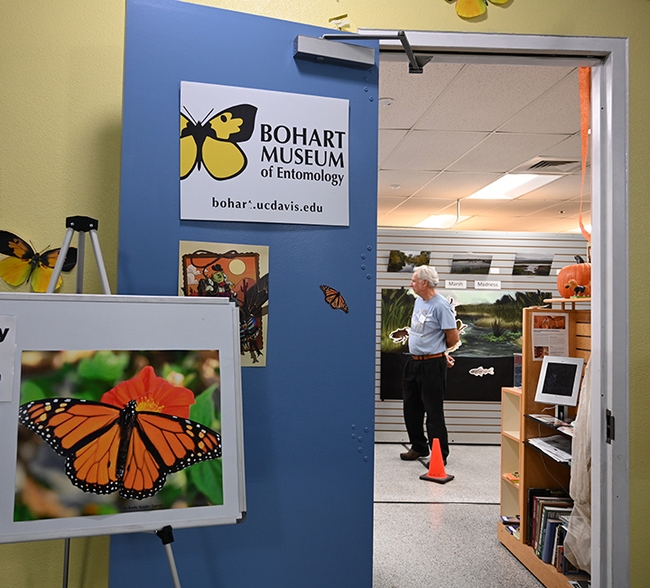

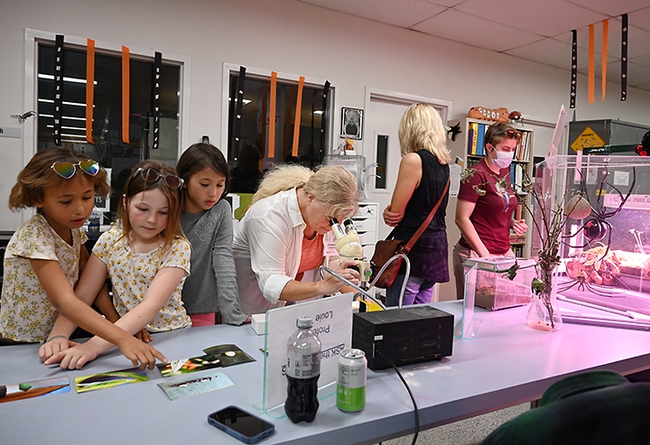
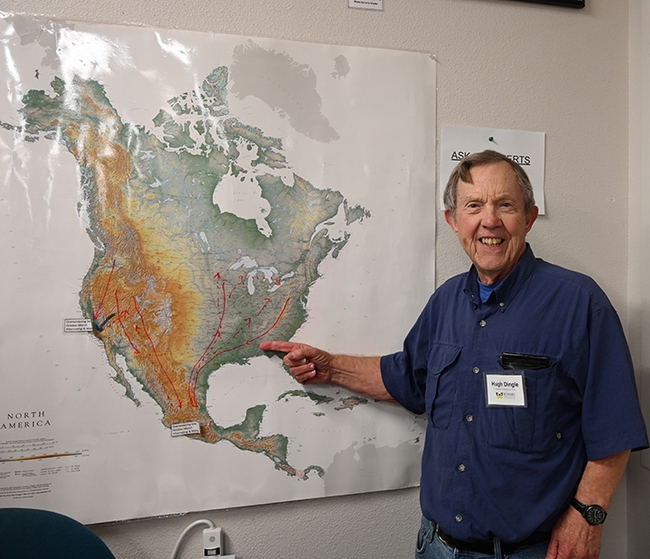
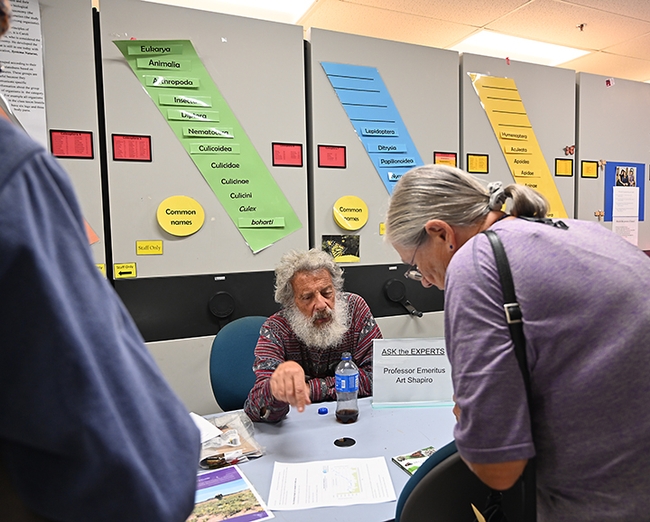
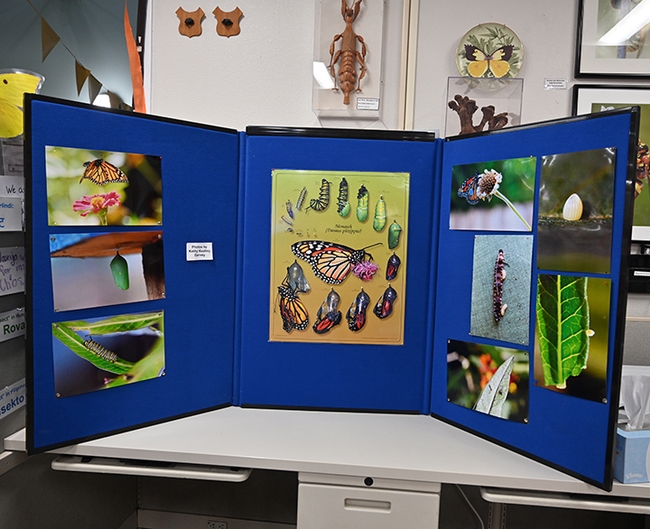
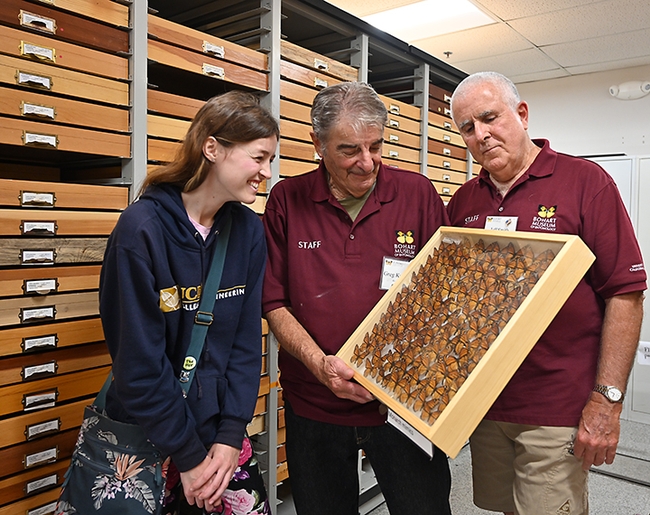
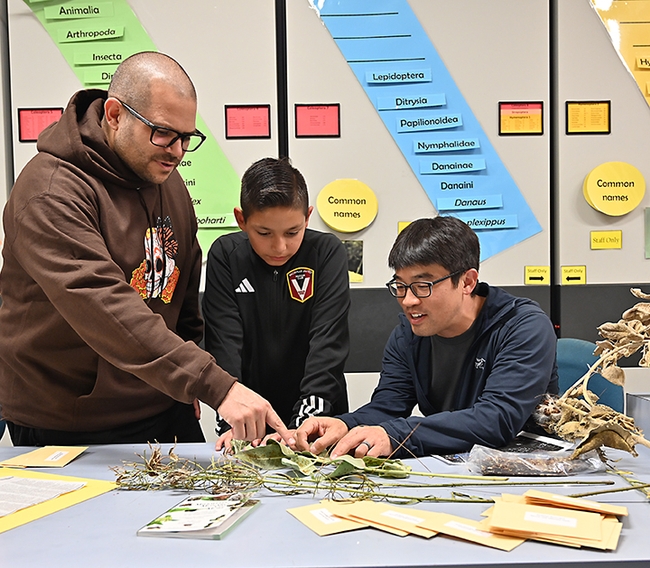
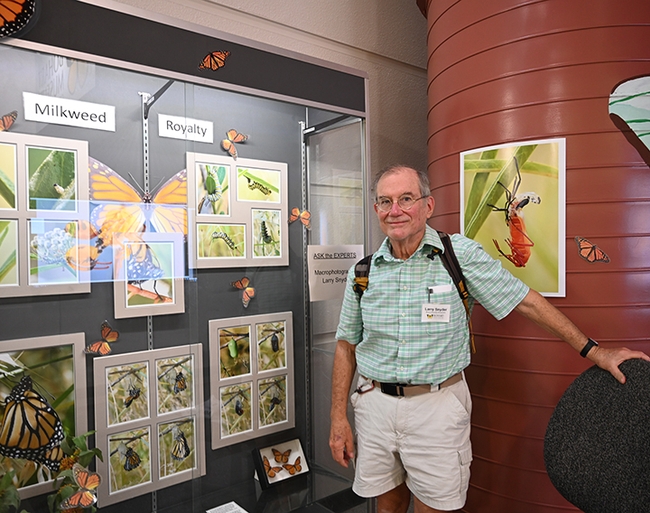
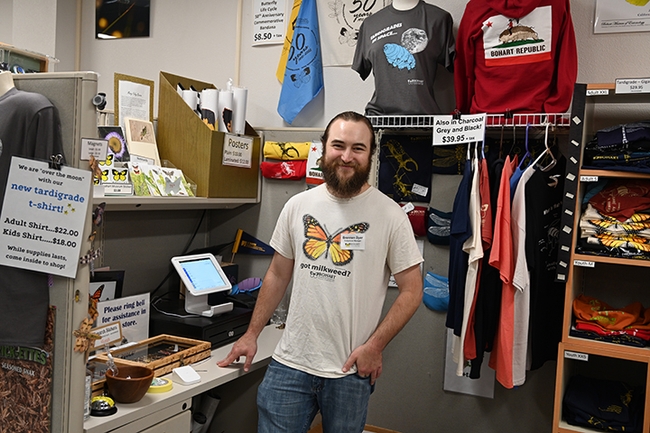
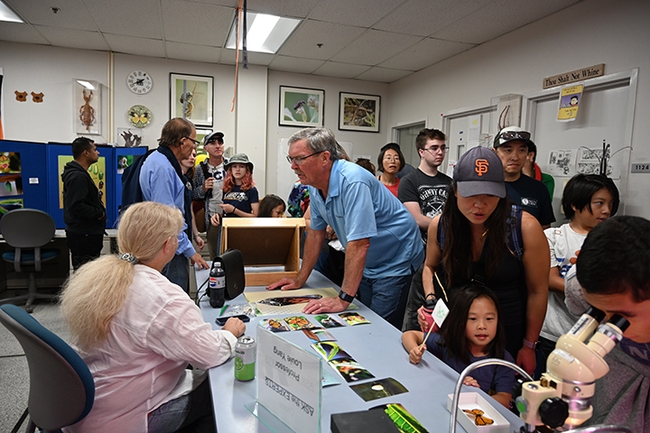
- Author: Kathy Keatley Garvey

It's early spring and Western monarchs are heading inland from their overwintering sites along the California coast.
Have you seen any monarchs?
A group of monarch researchers from Washington State University, Tufts University, University of California at Santa Cruz, and the Xerces Society for Invertebrate Conservation seek your participation in the Western Monarch Mystery Challenge to help gain insight as to where the monarchs go. They want to fill "a critical gap in knowledge about habitat needs of migrating monarchs in the spring."
“We are very excited to see so many western monarchs on the coast this winter!" said conservation biologist and lead researcher Cheryl Schultz, a professor in Washington State University's School of Biological Sciences, in noting that the 2021 Thanksgiving count directed by the Xerces Society of Invertebrate Conservation totaled 247,237, a 100-fold increase from the less than 2000 monarchs recorded in 2020. "Monarchs are resilient. Because the numbers are up this year, it is a fabulous opportunity to learn where they go when they leave the coast as they head to breeding areas."
The challenge, launched Feb. 14 and to end April 22 (Earth Day), is a call to action: If you see a monarch in the area of California, Oregon, Washington, Nevada, Idaho and Utah (see map below), what you do is report the sighting, take an image (a cell phone photo is fine) and enter it the campaign for a chance at a prize.

While on sabbatical at UC Davis, Crone presented a seminar Jan. 29, 2020 to the Department of Entomology and Nematology on "Why Are Monarchs Declining in the West?"
“Surprisingly, we don't really know where western monarch butterflies are during this time period, roughly mid-February through mid-May," Crone told the UC Davis crowd. "Future research will focus on filling this knowledge gap, as well as building quantitative knowledge of the western monarch demography throughout their complex annual life cycle, which is needed to understand the relative contributions of habitat at different points in the life cycle to population declines and recovery.”
Crone related that what fascinates her about monarchs is "the possibility that we can recover the western monarch population from its recent steep decline to being abundant again. This should be a problem we can fix."
The Western Monarch Mystery Challenge "is an opportunity to get even more people to participate in western monarch community science–and these animals need our help right now, more than ever," said conservation biologist Emma Pelton of the Xerces Society.
"We know they spend winter months (November to February) in groves along the California Coast, and start breeding in central California in May," the group of researchers wrote in an email. "However, we know little about where monarchs are in March and April. Solving the mystery of where western monarchs spend the spring is central to conserving and restoring the phenomenon of monarch migration in the West."
The call to action, they said, is simple:
- If you see a monarch outside the overwintering groves, take a picture (don't worry, it can be blurry). We suspect that monarchs spend the spring somewhere between the coast and the Central Valley
- Report it to iNaturalist (the app is free) OR email it to monarchmystery@wsu.edu and include species, date and location
- Be automatically entered to win a variety of prizes every week you report a sighting. Be sure to check your messages on iNaturalist if you use the app to submit sightings. If you upload a monarch photo from outside the overwintering sites (and not any from monarch rearing projects as these "skew the data and could jeopardize the quality and legitimacy of conservation plans) you will automatically be entered in a weekly prize drawing. Prizes include gift cards to REI and other awards. More information is available at https://labs.wsu.edu/conservation-biology/western-monarch-mystery-challenge/
To stay updated, follow the Western Monarch Mystery Challenge on Twitter, Facebook, and Instagram.
The Western Monarch Mystery Challenge is supported by the Monarch Joint Venture in collaboration with the Western Association of Fish and Wildlife Agencies, as part of its Western Monarch Conservation Plan, 2019-2069, a regional program to restore and recover monarch butterflies across the Western landscape.
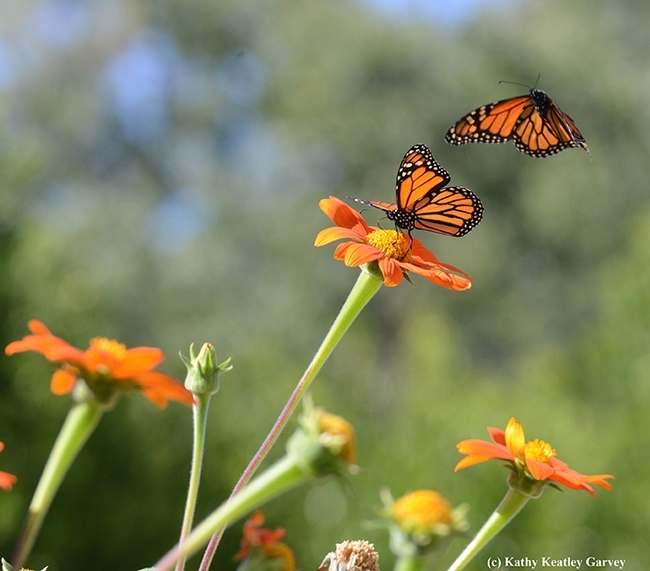
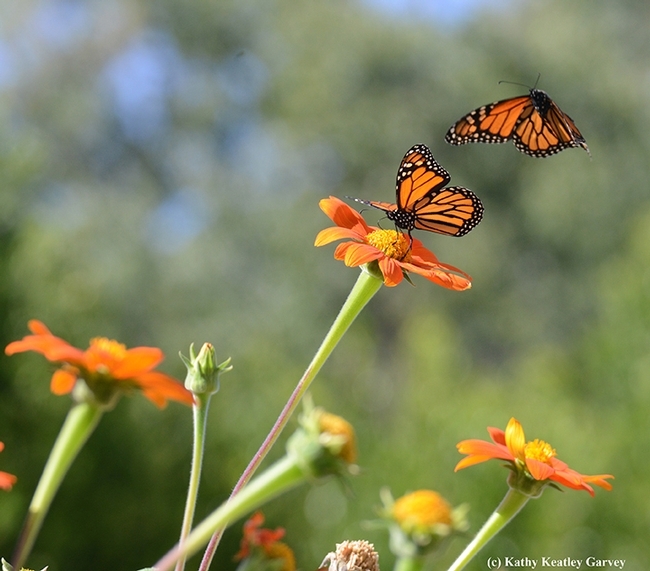
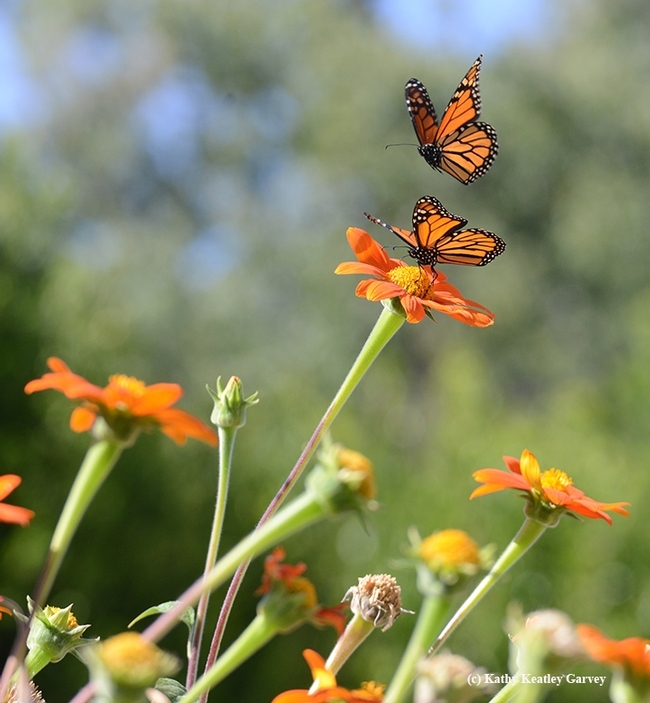


- Author: Kathy Keatley Garvey
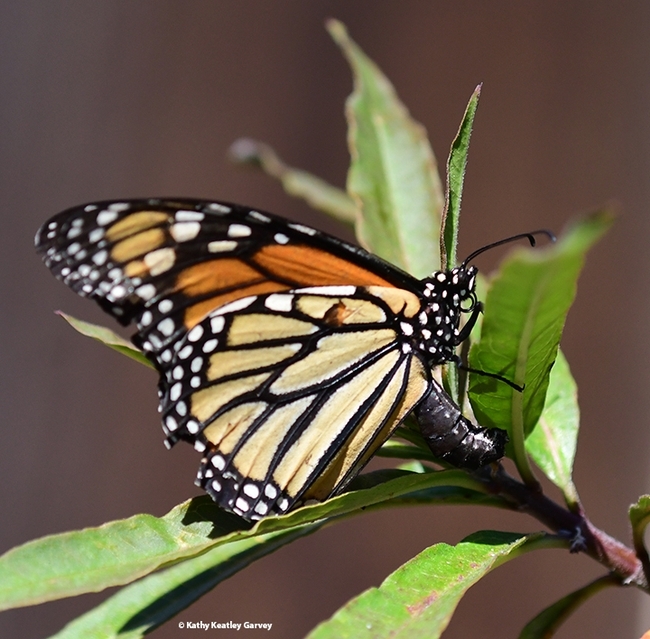
And how long misinformation can linger...
Take the news about the overwintering 250,000 monarchs recorded along the California coast in the Western Monarch Thanksgiving Count spearheaded by the Xerces Society for Invertebrate Conservation. That's more than a 100-fold increase from the previous year.
Butterfly guru Art Shapiro, a UC Davis distinguished professor of evolution and ecology who has been monitoring butterfly populations in Central California since 1972--and maintains a research website at https://butterfly.ucdavis.edu--wants to know where they came from. He acknowledges he does not know, nor does anyone else. Yet.
Lynn Kimsey, director of the Bohart Museum of Entomology and a UC Davis distinguished professor of entomology, says we shouldn't consider the population increase a trend, that it's still too early to figure out what's going on.
Says Bohart associate Greg Kareofelas: "I think it is hopeful, but we will not know for sure until 5 or 10 years have gone by. One year is not a trend."

- "It is great to have more breathing room, but we're not out of the woods yet, in terms of conservation. The current population is still < 5% of our estimates from the 1980's and has only been that large for one year."
- "When populations reach unprecedented sets of conditions (in this case, lower overwintering numbers than we had ever seen before, from 2018-2020), we should expect the unexpected. And one thing to emphasize is"
- "We expect large fluctuations in abundance of butterflies and many other insect species. We need to manage for resilience, because we probably won't be able to understand every crash or rebound." (See her UC Davis seminar)

But a key point is this: "There are NOT two populations of the monarch in North America," says migration expert and monarch scientist Hugh Dingle, emeritus professor, UC Davis Department of Entomology and Nematology. "The population is all one and the butterflies from all over North America mix in Mexico during the winter diapause. The monarchs breeding in the west (of the Rockies) have at least two (and probably three) migration routes in the fall--one is to the California coast, one is down the Colorado River Valley into Mexico, and the probable third is east of the Great Salt Lake and west of the Wasatch down through eastern Arizona and into Mexico. Sample sizes are small for the third route which is why it is only probable. Also genetic data going back 50 years shows that the North American population is all one, that is, work by Walter Eanes and others including recent molecular genetics studies!"
The western migration routes are outlined in Dingle et al. Biological Journal of the Linnaean Society 85:491-500 (2005), and for various evolutionary changes in monarch migration and correlated characters see Freedman, Dingle, et al. B. J. Linn. Soc. 123:265-278 (2018), Animal Migration 5:61-73 (2018), and the Proceedings of the National Academy of Sciences (PNAS) 117: 28887-28893(2020) and references therein.
Commented Dingle: "The old saw about two North American populations is a good example of once something gets into the literature--or into the public domain-- it becomes exceedingly difficult to correct."
Now scientists are trying to figure out what contributed to the increase in the population. And where they came from.
Remember back in 2019 when Shapiro declared that the monarch population is on life support?
Hold on...
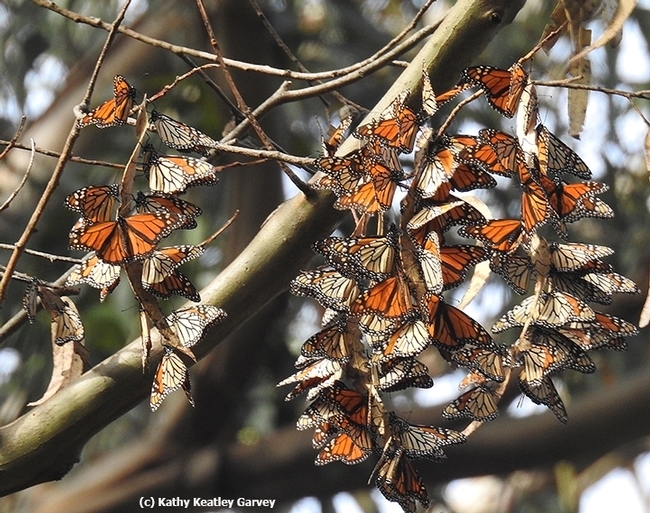
- Author: Kathy Keatley Garvey
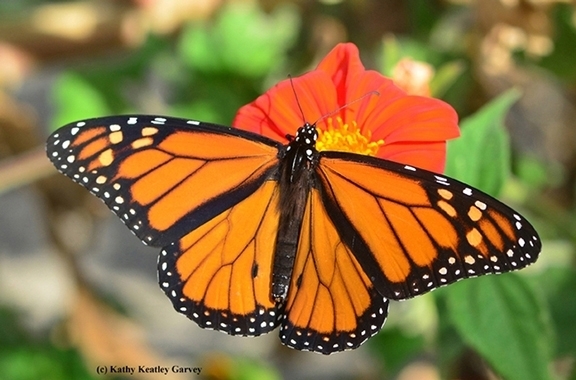
Professor Elizabeth Crone of Tufts University who researches monarchs (as well as bumble bees), drew a standing-room only crowd when she presented a UC Davis Department of Entomology and Nematology seminar on the decline of Western monarchs.
UC Davis professor Neal Williams, a pollination ecologist who researches native bees, praised her "fearless perspective in the use of statistics; I value her insights." Williams has collaborated with her "off and on" for 20 years.
Crone, who just finished a six-month research sabbatical at UC Davis, says her work centers on population ecology, especially of plants and insects, and plant-animal interactions. "Specifically, I am interested in how environmental changes translate to changes in population dynamics: For example, is there a simple, linear matching of changes in resources to abundance of consumers, or do interactions among individuals and species moderate these responses? Much of my research also involves developing novel quantitative approaches to predict long-term dynamics from small scale observations and experiments. Current projects include studies of butterflies, bees, perennial wildflowers, sugar maples, and acorn-granivore interactions."
In her UC Davis seminar, Crone pointed out that the population of Western monarchs, which overwinter along the California coast, dropped from an estimated 4.5 million in the 1980s to less than 30,000 in the winter of 2019.
After the monarchs leave their overwintering sites in February and head inland, "we don't really know where they are in spring," Crone lamented. "There's not a lot of records of where monarchs are in spring. That's why we're trying to draw on citizen scientists to help us find monarch butterflies in the spring."
Crone is a member of a team of researchers, led by Cheryl Schultz, biology professor at Washington State University, who are recruiting the public, aka citizen scientists, to report sightings of monarchs from Feb. 14 through April 22, Earth Day. The project is called the Western Monarch Mystery Challenge.
To participate in the Western Monarch Mystery Challenge:
- If you see a monarch outside of overwintering groves, take a picture! (Don't worry, it can be far away and blurry.)
- Report it to iNaturalist (the app is free) OR email MonarchMystery@wsu.edu and be sure to include date, species and location for both methods
- You will automatically be entered to win a variety of prizes every week you report a sighting.
All data will be added to the Western Monarch Milkweed Mapper, a year-round community science project tracking milkweeds and monarchs in the West.
Crone told the UC Davis crowd that "we need to understand the basic biology throughout the life cycle....So from a conservation perspective, we know that we need to protect and restore overwintering sites on the coast of California...It also helps to improve summer habitat both for its own sake and maybe to mitigate losses. It other places, this includes planting your own pollinator gardens. It includes minimizing ;pesticide use society-wide."
It's not just agriculturists who use pesticides, said Crone, noting that "California tracks pesticide use." She showed a database that indicated 25 percent of the state's total pesticide use is for non-agricultural uses. This includes pesticide applications in parks, roadsides and golf courses, she said. "That doesn't include people who go to Lowe's or Home Depot and pick up a can of insecticide to prevent the aphids from eating their roses. And read the label and it says, 'Why don't you just spray every week so you never see aphids at all?' So we should be very aware that pesticides are everywhere in our landscape, and a lot of us are using them without thinking about them. And anything we can do to minimize pesticides has got to be good for nearly all insects."
From an applied ecology perspective, Crone considers her biggest accomplishment "helping the Fender's blue butterfly move from being listed as endangered to nearly ready for down-listing. From a basic ecology perspective, I figured out the ecological interpretation of variance terms in mixed models as estimates of spatial heterogeneity and environmental stochasticity, and worked out one of the best examples of how mast-seeding species are synchronized by their pollinators."
"It's an exciting time to be an ecologist," Crone said. "Because the puzzle of linking natural history and theoretical ecology to guide conservation is really intellectually interesting, even from an academic perspective. And it also makes me optimistic."
"We did it with Fender's blue butterfly," she told the crowd. "Maybe we can help prevent other insect populations from being at risk of extinction."
To listen to her talk, access this newly uploaded video from ucdavis.edu/media. Access is free.
